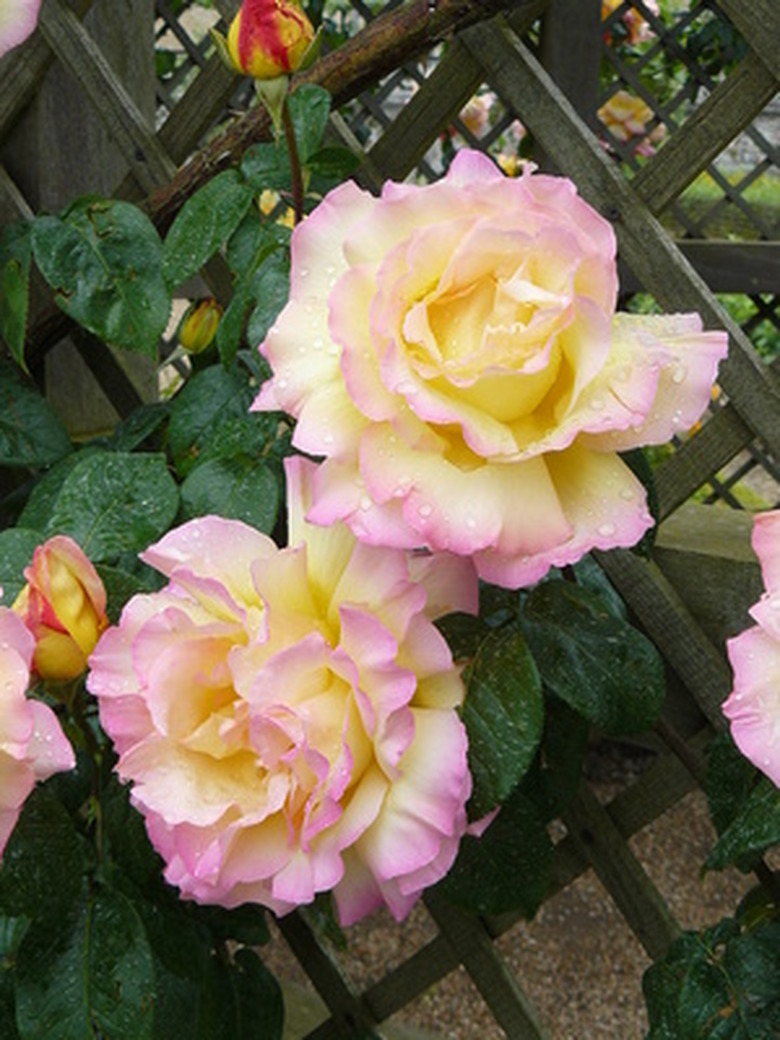Do Aphids Bite?
Aphids (Aphis spp.) do not bite human beings or chew plant leaves. Instead, these small, soft-bodied insects insert microscopically thin, piercing mouthparts into plant leaf and stem phloem and feed off of sugar-rich plant juices. Commonly called plant lice, colonies of aphids inject saliva into plants as they suck fluids. The saliva prevents wound healing, causing leaves to curl and become distorted.
Identification
Step 1
Pear-shaped, soft aphid bodies are 1/16 to 1/4 inch long, and may be winged or wingless. Aphids have three pair of long, slender legs and conspicuous, long antennae. At the rear of the body, an aphid has two additional projections called cornicles. Varying from little more than pores in certain species to horn-like tubes in others, cornicles secrete a lipid fluid, which is a waste product of the insect's high carbohydrate diet. Although most aphid species are green or black, some aphids are gray, pink, lavender, yellow, brown or red. Certain aphid species have a waxy or woolly appearance due to body secretions.
- do not bite human beings or chew plant leaves.
- Commonly called plant lice, colonies of aphids inject saliva into plants as they suck fluids.
Life Cycle
Step 1
The aphid reproductive cycle adjusts to environmental conditions to maximize survival of the species. During active plant growth, when food sources are plentiful, all aphids are female and reproduce parthenogenetically — without mating. Female aphids give birth to live young, sometimes birthing 12 nymphs a day. Young aphids mature in approximately 10 days. Some aphids develop wings, which allow them to spread to other plants. In the autumn, as day length shortens and food sources become more scarce, both male and female aphids are born, creating a generation capable of mating and producing eggs. Stuck to plant leaves and stems, eggs overwinter and produce female aphids the following spring.
- The aphid reproductive cycle adjusts to environmental conditions to maximize survival of the species.
- Female aphids give birth to live young, sometimes birthing 12 nymphs a day.
Honeydew
Step 1
As sap suckers, aphids produce a sugary waste called honeydew, which attracts certain types of ants. The ants take advantage of the food source produced by the aphids and the two have developed a mutually beneficial relationship. Ant shepherds move aphids from declining plants to succulent plants and even overwinter aphid eggs in their burrows. Ants eat honeydew off of plants or stroke aphids with their antennae to stimulate the secretion of honeydew droplets. To protect their food source, ants sometimes fight off aphid predators. Ants, however, exploit aphids by preventing them from leaving the colony by chewing off their wings or emitting a chemical that prevents young aphids from developing wings.
Damage
Step 1
Although aphids don't bite, they do cause damage. Aphid species feed off of many types of plants, including food crops, ornamentals and trees. Colonies of aphids suck vital juices out of tender plant growth, stunting plants. Viral diseases are sometimes transmitted to plants as aphids feed on their juices. And the honeydew secreted by aphids promotes black fungal growth, resulting in a sooty covering on plant leaves, which can interfere with photosynthesis.
- As sap suckers, aphids produce a sugary waste called honeydew, which attracts certain types of ants.
- Ants eat honeydew off of plants or stroke aphids with their antennae to stimulate the secretion of honeydew droplets.
References
- UC IPM Online: Aphids
- North Carolina Cooperative Extension: Aphids
- University of Illinois Extension: Aphids
- Virginia Cooperative Extension: Aphids
- Annals of the Entomological Society of America: Structure and Function of Aphid Cornicles
- Map of Life: Sap Feeding and Honey-Dew Production in Insects
- Insects: Honeypot Ants
- Science Daily: Herding Aphids: How Farmer Ants Keep Control of Their Food
